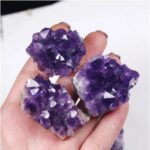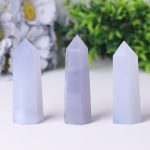A Kaleidoscope of Hues: Shades of Purple in Precious Stones
The captivating allure of purple gemstones lies in their vibrant hues and timeless beauty. This enchanting color spectrum ranges from soft lilacs to deep amethysts, each shade evoking a distinct emotion and symbolism.

- Amethyst: The most well-known purple gemstone, amethyst, boasts a deep and regal purple hue. Its name originates from the Greek word “amethystos,” meaning “not drunk,” as it was believed to ward off drunkenness.
- Charoite: A relatively rare stone, charoite exhibits swirls of lavender, purple, and black, creating a mesmerizing and otherworldly effect.
- Sugilite: A relatively new discovery, sugilite is a vibrant and opaque purple gemstone. It is named after the Japanese geologist Ken-ichi Sugi, who discovered it in 1944.
- Tanzanite: A gemstone of exceptional rarity, tanzanite is found almost exclusively in Tanzania. It displays a captivating blue-violet hue that shifts to purple under certain lighting conditions.
- Lavender Spinel: A more affordable purple gemstone, lavender spinel exhibits a delicate and ethereal shade. Its gentle hue makes it a popular choice for everyday jewelry.
Mystical and Metaphysical Properties of Purple Gemstones
Purple gemstones have long been associated with spiritual enlightenment, intuition, and emotional healing.
- Amethyst: Believed to possess calming and soothing properties, amethyst is said to promote inner peace and reduce stress.
- Charoite: Associated with the heart chakra, charoite is believed to foster emotional balance and enhance self-love.
- Sugilite: Known as the “stone of love,” sugilite is said to promote emotional connection, empathy, and understanding.
- Tanzanite: Believed to stimulate creativity and spiritual awareness, tanzanite is often used in meditation practices.
- Lavender Spinel: Associated with intuition and wisdom, lavender spinel is said to enhance mental clarity and promote a sense of well-being.
Mining and Production of Purple Gemstones
The mining and production of purple gemstones is a complex and fascinating process.
- Amethyst: The majority of amethyst is mined in Brazil, Zambia, and Namibia. It is also extracted in smaller quantities in the United States, Canada, and Russia.
- Charoite: Found exclusively in the Murun Mountains of Siberia, charoite is a rare and highly sought-after gemstone.
- Sugilite: Sugilite is primarily mined in the Lavrion region of Greece. It is also found in smaller deposits in South Africa, Canada, and Japan.
- Tanzanite: As mentioned earlier, tanzanite is found almost exclusively in the Merelani Hills of Tanzania. It is a relatively new gemstone, having been discovered in the 1960s.
- Lavender Spinel: Lavender spinel is found in alluvial deposits in Sri Lanka, Tanzania, and Myanmar. It is also mined in smaller quantities in Madagascar and Vietnam.
Applications and Innovations in Purple Gemstone Industry
Beyond their traditional uses in jewelry and ornamentation, purple gemstones are finding innovative applications in various industries.
- Technology: Purple gemstones are used in optical components, lasers, and other electronic devices due to their unique optical properties.
- Health and Wellness: Certain purple gemstones, such as amethyst and charoite, are believed to have therapeutic effects. They are used in energy healing and crystal therapy.
- Metamaterial: Researchers are exploring the use of purple gemstones in the development of metamaterials, which are engineered materials with unique optical and electromagnetic properties.
Gemological Properties of Purple Gemstones
The gemological properties of purple gemstones are essential for identifying and evaluating their quality.
Table 1: Gemological Properties of Purple Gemstones
| Gemstone | Chemical Composition | Hardness (Mohs Scale) | Specific Gravity | Refractive Index |
|---|---|---|---|---|
| Amethyst | SiO2 (Silicon Dioxide) | 7 | 2.65 – 2.69 | 1.544 – 1.553 |
| Charoite | K(Ca,Na)2Si4O10(OH,F)·H2O | 5 – 6 | 2.72 – 2.81 | 1.550 – 1.580 |
| Sugilite | Na8(Fe,Mn,Li)2Li(Si4O12)2S | 5.5 – 6.5 | 2.75 – 2.85 | 1.590 – 1.603 |
| Tanzanite | (Ca,Sr,Ba)(Ti,Nb)2O6 | 6.5 – 7 | 3.33 – 3.47 | 1.707 – 1.723 |
| Lavender Spinel | MgAl2O4 | 8 | 3.58 – 3.62 | 1.714 – 1.720 |
Jewelry Styles and Inspiration
Purple gemstones are versatile and lend themselves to a wide range of jewelry styles.
- Antique and Victorian: Purple gemstones were highly prized in the Victorian era and are often featured in antique jewelry designs.
- Modern and Contemporary: Purple gemstones are frequently incorporated into modern jewelry pieces, such as geometric pendants and minimalist earrings.
- Art Deco: The bold and geometric designs of the Art Deco period often showcase purple gemstones, such as amethyst and charoite.
- Statement Pieces: Purple gemstones are perfect for making a statement, whether in a large pendant, a dramatic ring, or a chunky necklace.
- Everyday Wear: More affordable purple gemstones, such as lavender spinel, make excellent choices for everyday jewelry that adds a touch of color and elegance.
Market Value and Trends
The value of purple gemstones varies depending on several factors, including scarcity, quality, and demand.
- Tanzanite: Tanzanite is the most expensive purple gemstone, due to its rarity and unique color. Prices can range from a few hundred dollars to tens of thousands of dollars per carat.
- Charoite: Charoite is also relatively expensive, with prices typically ranging from a few hundred dollars to a few thousand dollars per carat.
- Amethyst: Amethyst is a more affordable purple gemstone, with prices ranging from a few dollars to a few hundred dollars per carat.
- Sugilite: Sugilite is moderately priced, with prices typically ranging from a few hundred dollars to a few thousand dollars per carat.
- Lavender Spinel: Lavender spinel is the most affordable of the major purple gemstones, with prices typically ranging from a few dollars to a few hundred dollars per carat.
Investment Potential
Investing in purple gemstones can be a lucrative option for those with a long-term investment horizon.
- Rarity: Many purple gemstones are rare, which can contribute to their investment value.
- Demand: The demand for purple gemstones is increasing, driven by growing interest in colored gemstones and spiritual healing practices.
- Historical Appreciation: Purple gemstones have shown a history of appreciating in value over time, especially rarer varieties like tanzanite and charoite.
- Diversification: Investing in purple gemstones can help diversify a portfolio and reduce overall risk.
Conclusion
The captivating allure of purple gemstones lies in their vibrant hues, mystical properties, and timeless appeal. Whether in exquisite jewelry designs, innovative applications, or as potential investments, these precious stones continue to enchant and inspire. As the demand for colored gemstones and the pursuit of emotional well-being rise, the future of purple gemstones looks bright.
Table 2: Major Purple Gemstone Producers by Country
| Gemstone | Primary Producing Country |
|---|---|
| Amethyst | Brazil, Zambia, Namibia |
| Charoite | Russia |
| Sugilite | Greece |
| Tanzanite | Tanzania |
| Lavender Spinel | Sri Lanka, Tanzania, Myanmar |
Table 3: Emotional Benefits Associated with Purple Gemstones
| Gemstone | Emotional Benefits |
|---|---|
| Amethyst | Calming, Stress Relief, Inner Peace |
| Charoite | Emotional Balance, Self-Love |
| Sugilite | Love, Empathy, Understanding |
| Tanzanite | Creativity, Spiritual Awareness |
| Lavender Spinel |




























